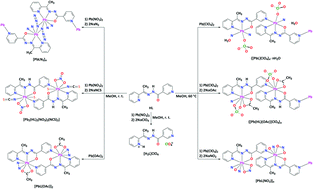Anion-driven tetrel bond-induced engineering of lead(ii) architectures with N′-(1-(2-pyridyl)ethylidene)nicotinohydrazide: experimental and theoretical findings†
Abstract
The evaluation of N′-(1-(2-pyridyl)ethylidene)nicotinohydrazide (HL) as a linker for the PbII tagged extended structures is described. The reaction of Pb(ClO4)2 or Pb(OAc)2 with HL in MeOH at 60 °C and room temperature, respectively, leads to heteroleptic complexes {[PbL]ClO4}n·nH2O and [PbL(OAc)]2, while the same reaction of Pb(ClO4)2 with HL at 60 °C in the presence of two equivalents of NaOAc or NaNO2 leads to heteroleptic complexes {[Pb(HL)(OAc)]ClO4}n and [PbL(NO2)]n, respectively. Using Pb(NO3)2 as a source of PbII in the same reaction with HL and two equivalents of NaN3 or NaNCS at room temperature yields [PbLN3]n and [Pb2(HL)2(NO3)2(NCS)2], respectively. The room temperature reaction of Pb(NO3)2 with HL in the presence of two equivalents of NaClO4 leads to the transformation of the parent ligand to its perchlorate salt [H2L]ClO4. In all the obtained PbII structures, HL or its deprotonated form L acts both as a chelating and a bridging ligand. The nature of the inorganic anion also influences the final structure. In all complexes the PbII center exhibits a hemidirected coordination geometry with all the covalent bonds being concentrated on one hemisphere of the coordination sphere with the closest approach of two atoms on the other side varying from 151° to 232°. The sterically available PbII ion participates in tetrel bonding as evidenced from the detailed structural analysis of the described complexes. As a result of tetrel bonding, the structures of all the six compounds can be extended to a higher dimensional framework, which is further stabilized by π⋯π stacking interactions between the aromatic rings. The DFT based charge and energy decomposition (ETS-NOCV) calculations are performed in order to shed light on the nature of non-covalent interactions that determine the stability of the obtained structures.

- This article is part of the themed collection: HOT articles in Inorganic Chemistry Frontiers for 2016

 Please wait while we load your content...
Please wait while we load your content...